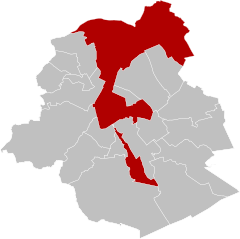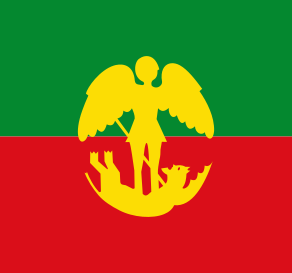|
City of Brussels
The City of Brussels[a] is the largest municipality and historical centre of the Brussels-Capital Region,[b] as well as the capital of the French Community of Belgium, the Flemish Region (from which it is separate) and Belgium.[2] The City of Brussels is also the administrative centre of the European Union, as it hosts a number of principal EU institutions in its European Quarter.[3][4][c] Besides the central historic town located within the Pentagon, the City of Brussels covers some of the city's immediate outskirts within the greater Brussels-Capital Region, namely the former municipalities of Haren, Laeken, and Neder-Over-Heembeek to the north, as well as the Avenue Louise/Louizalaan and the Bois de la Cambre/Ter Kamerenbos park to the south-east, where it borders municipalities in Flanders. As of 1 January 2024[update], the City of Brussels had a population of 196,828 inhabitants.[5] The total area is 33.09 km2 (12.78 sq mi), which gives a population density of 5,949/km2 (15,410/sq mi).[5] As of 2023[update], there were 75,998 registered non-Belgians in the City.[6] In common with all of Brussels' municipalities, it is legally bilingual (French–Dutch). Territorial historyHistorically, the City of Brussels was simply defined, being the area within the second walls of Brussels, the modern-day Small Ring (Brussels' inner ring road). As the city grew, so did the surrounding villages, eventually forming a contiguous city, though the local governments retained control of their respective areas.  At the country's independence in 1830, the new members of the Belgian upper class hoped to create a new prestigious residential area in the capital. An official plan for the Leopold Quarter was drawn up in 1838, marking the first major extension of the City of Brussels in its eastern part, following the transfer of a large area of the municipality of Saint-Josse-ten-Noode. The area was designed to emanate from Brussels Park (located in front of the Royal Palace), and was laid out on a grid in a traditional classical pattern centred around the Square Frère Orban/Frère-Orbansquare. Shortly afterwards, in 1844, the Avenue Louise/Louizalaan was proposed as a monumental avenue bordered by chestnut trees that would allow easy access from Brussels' city centre to the popular recreational area of the Bois de la Cambre/Ter Kamerenbos.[7][8][9] However, fierce resistance to the project was put up by the towns of Saint-Gilles and Ixelles—then, as now, separate municipalities (local authorities) from the City of Brussels—through whose territories the avenue was to run.[10] After years of fruitless negotiations, the City of Brussels finally annexed the narrow band of land needed for the avenue, in addition to the Bois de la Cambre itself, in April 1864.[11][12][9] That decision accounts for the unusual shape of today's City of Brussels and for the separation of Ixelles into two separate areas. To the east, in 1853, following the bankruptcy of Saint-Josse's municipal administration, the City of Brussels purchased half of this municipality. Nowadays, this is the Squares Quarter, the only part of the Brussels municipality to have the same postal code (1040) as the municipality of Etterbeek. Further east, in 1880, a former military exercise ground and the surrounding land, also located in Etterbeek, were attached to the City to create the Parc du Cinquantenaire/Jubelpark, an exhibition space commemorating the 50th anniversary of independence. A leisure park and museums were subsequently set up there. Unlike most of the municipalities in Belgium, the ones now located in the Brussels-Capital Region were not merged with others during mergers occurring in 1964, 1970, and 1975.[13] However, a few neighbouring municipalities have been merged into the City of Brussels, including Haren, Laeken and Neder-Over-Heembeek in 1921.[14] These comprise the northern bulge in the municipality. To the south-east is the above-mentioned strip of land along the Avenue Louise that was annexed from Saint-Gilles and Ixelles. Part of the Université libre de Bruxelles (ULB)'s Solbosch campus is also part of the City of Brussels, partially accounting for the bulge in the south-eastern end. DemographicsHistorical populationAs of 1 January 2024[update], the City of Brussels' population was 196,828 inhabitants.[5] The area is 33.09 km2 (12.78 sq mi), making the density 5,949/km2 (15,410/sq mi).[5] Taking into account the current municipality, including the former municipalities annexed in 1921 (Haren, Laeken and Neder-over-Heembeek) from 1831: 
Foreign populationThe City of Brussels has a large immigrant population, with both the EU and non-European migrant communities outnumbering the native Belgians. Akin to neighbouring Ixelles, Etterbeek and Schaerbeek, the City of Brussels also has a large Muslim population, mainly of North African origin. As of 2023[update], taking into account the nationality of birth of the parents, 55.84% of the City of Brussels's population is of non-European origin (predominantly Moroccan, Indian and Congolese), 27.21% is of European origin other than Belgian (mainly French, Romanian, Italian, Spanish, and Polish), while 16.94% is solely of native Belgian ancestry.[15] Among all major migrant groups from outside the EU, a majority of the permanent residents have acquired Belgian nationality.[16] Migrant communities in the City of Brussels with over 1,000 people as of 1 January 2020:[17]
PoliticsAs in every other Belgian municipality, the City of Brussels is headed by a mayor, who should not be confused with the Minister-President of the Brussels-Capital Region or the Governor of Brussels-Capital. The current city council was elected in the October 2018 elections.[20] The current mayor of the City of Brussels is Philippe Close, a member of PS, who is in coalition on the municipal council with Ecolo - Groen, DéFI and Forward.[21]
Environmental policyBrussels is ranked sixth in the index of cities which are becoming greener fastest as for the year 2022, even though in the past it had a reputation of a "traffic-choked city of high rises and concrete". The authorities released a plan composed of seven steps on how to make the city even more sustainable. Those include introducing "a use-based, circular and low-carbon economy" and making the city "proactive". The city should become a "10-minute city" meaning "making the facilities essential to urban life accessible to every inhabitant in less than 10 minutes". Green spaces should be expanded. The plan includes participation of the population in decision-making and high life level for all.[22] CultureMuseumsThere are many museums in and around Brussels' city centre. On the first Sunday of every month, free entry is granted to many of Brussels' museums. Below is a non-exhaustive list of museums in the City of Brussels:
FoodBrussels is well known for its food. Brussels sprouts were named after the city.[23] Like most of Belgium, moules-frites, waffles (gaufres), chocolate, French fries, and beer are common there.[24] It is home to one 2-starred and four 1-starred Michelin restaurants.[25] Honorary citizensAmong the recipients of the honorary citizenship of the City of Brussels are:[26]
SymbolsHeraldry
Vexillology
See also
ReferencesFootnotes
Citations
Bibliography
External linksWikimedia Commons has media related to Brussels (municipality).
Information related to City of Brussels |
|||||||||||||||||||||||||||||||||||||||||||||||||||||||||||||||||||||||||||||||||||||||||||||||||||||||||||||||||||||||||||||||||||||||||||||||||||||||||||||||||||||||||||||||||||||||||||||||||||||||||||||||||||||||||||||||||||||||||||||||||||||||||||||||||||||||||||||||||||||||||||||||||||||||||||||||||||||||||||||||||||||||||||||||












